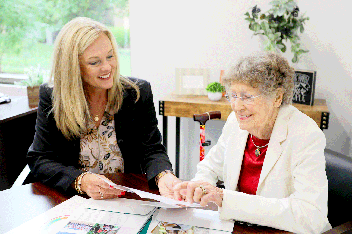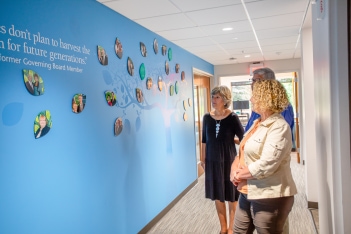
Michael M. Parks
As we continue to highlight equity and inclusion in this column, I’d like to shed some light on an issue that 36 percent of our region’s citizens face on a daily basis: low access to fresh food. This column’s featured experts are Amaha Sellassie and Lela Klein, local social justice advocates who were driving forces behind creating Gem City Market, one of the community’s most impactful efforts to address food equity to date.
Amaha is a self-described peace builder, social healer, freedom fighter and lover of humanity. A professor of sociology at Sinclair Community College, he also co-founded West Dayton Strong and is president of the Gem City Market Board. Lela, who received her juris doctor degree from Harvard Law School, is co-founder of Co-op Dayton, a nonprofit organization that develops cooperative businesses to meet community needs, such as Gem City Market. She has used her legal and organizational training to fight for economic justice and support local economic development and worker empowerment since returning to Dayton in 2012.

Amaha Sellassie and Lela Klein of Gem City Market
What is food apartheid? What areas in Greater Dayton are hardest hit by this issue?
Amaha: Food apartheid is the intentional underdevelopment of an area resulting in a lack of access to fresh food, especially produce. Historically, the term has been tied to redlining and disinvestment in neighborhoods with high concentrations of Black people. A “food desert” sounds like a naturally occurring phenomenon. “Food apartheid” is a term that acknowledges human agency – that inequality didn’t happen naturally, but is “manmade” because of policy choices that have been made and sustained over decades.
West Dayton is the hardest hit by this issue. Trotwood, Jefferson Township and some neighborhoods in North Dayton and East Dayton are deeply impacted by a lack of food access.
Lela: Although the term food apartheid can feel more negative than food desert when you first hear it, the positive is that if something is the result of human design, it gives us hope that it can be changed.
How are efforts like Gem City Market making food more accessible for individuals most impacted by food apartheid?
Lela: May 13 is the one-year anniversary of our opening day. It’s been an exciting, if bumpy, first year of operations. We’ve been learning the grocery industry and weathering a volatile time for pricing and supply chain, but we feel that in the first quarter of 2022, we’re finally hitting our stride. On average, we’re serving about 300 to 350 people per day and it’s getting closer to 400 as we finally head out of the “omicron” winter. We are on track for $3 million in sales for our first year and have created 30 jobs, all of which start at a living wage for Dayton. We estimate close to 20,000 people are no longer living in census tracts that meet the USDA definition of a food desert.
There are exciting developments happening around the city, but it’s vital that neighbors have a voice in how that development happens in their neighbor-hoods and have direct benefit from the outcomes.
– Amaha Sellassie
Amaha: We countered food apartheid by bringing together more than 5,000 people as member-owners of the cooperative market to create increased and affordable access to fresh food. Neighbors co-created it, and the community came together to design, conceptualize and develop it. It’s a tangible manifestation of hope and a symbol that we have the power to do big things when we come together.
What do you see as the community’s greatest challenges regarding equity and inclusion?
Amaha: The biggest challenge is lack of centering the voice of the people most impacted by the issues of inequality. The community understands its needs but is not always positioned or at the table to voice those needs and shape funding and policy decisions. There are exciting developments happening around the city, but it’s vital that neighbors have a voice in how that development happens in their neighborhoods and have direct benefit from the outcomes.
Lela: I think we’ve made real progress over the past few years in recognizing the way resources in Dayton have been concentrated in the hands of a few and in understanding the ways even facially neutral policies and practices can contribute to inequitable outcomes. But it can be hard to challenge the status quo when it is what we are comfortable with and even works to some people’s benefit. I think we need more dialogue, more openness to constructive critiques of even our most beloved and longstanding institutions, and more focus on impact rather than intent.
Amaha and Lela: The Foundation and its fund holders played a critical role in getting the Gem City Market off the ground, for which we are deeply grateful. Going forward, they could drive resources and help pull together partners in the community for honest dialogue about what real change will take. We know that community-centered work doesn’t happen overnight. For people who have been subject to divestment and marginalization, building trust with institutions and organizations takes time, and community-led change moves at the speed of trust. Sustained funding that recognizes this reality would help build capacity and collaboration.
Multi-year commitments for funding are unusual among local grantmakers but necessary for organizations led by those who have been most disadvantaged. We’ve been excited in recent years to see some of the bigger Dayton nonprofits receive funding for planning and strategy. That kind of funding – tied to planning rather than a specific project or service – also is needed within the community or for more grassroots groups. Along these lines, we love that The Dayton Foundation is focused now on building resources and capacity with smaller grassroots organizations, especially Black-led groups. Empowering these groups is essential, as we transform these groups and the individuals they serve from recipients of policy and strategic planning into co-creators of their shared future.








